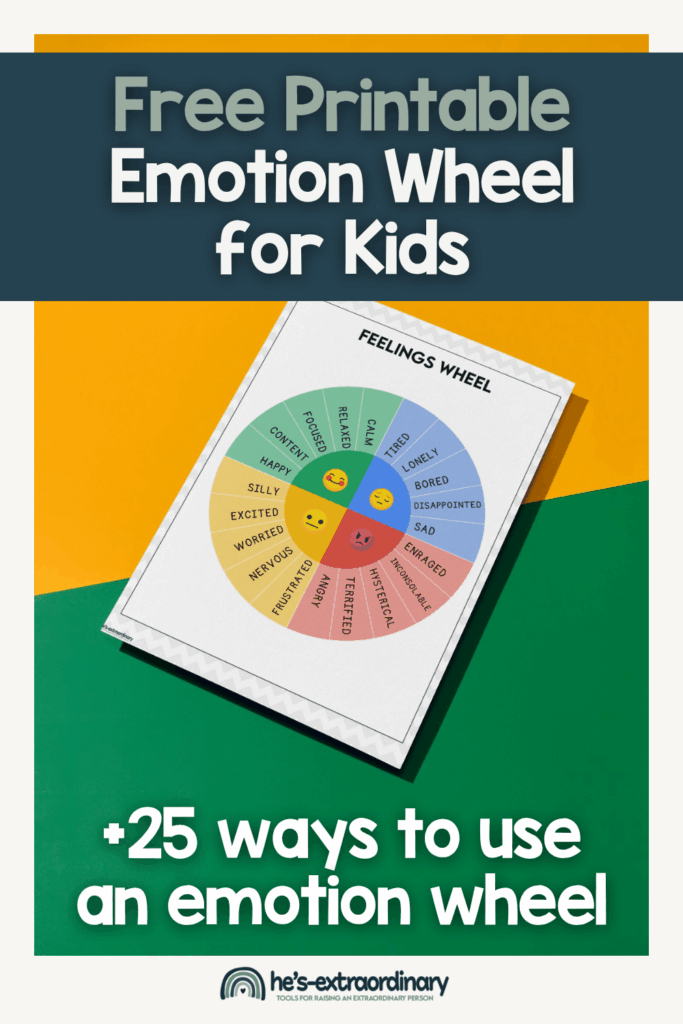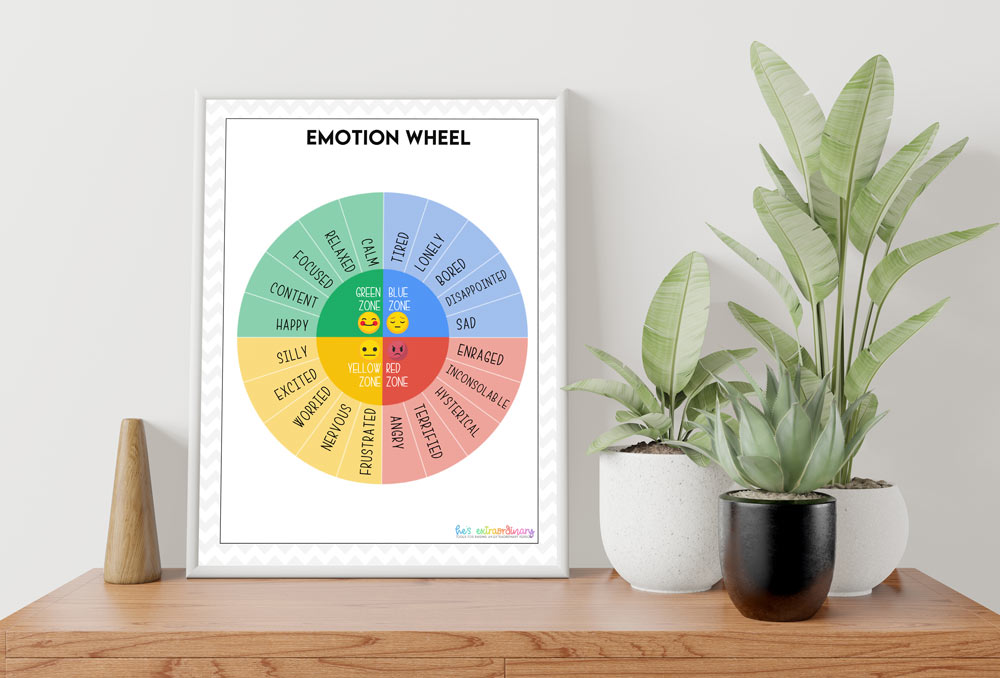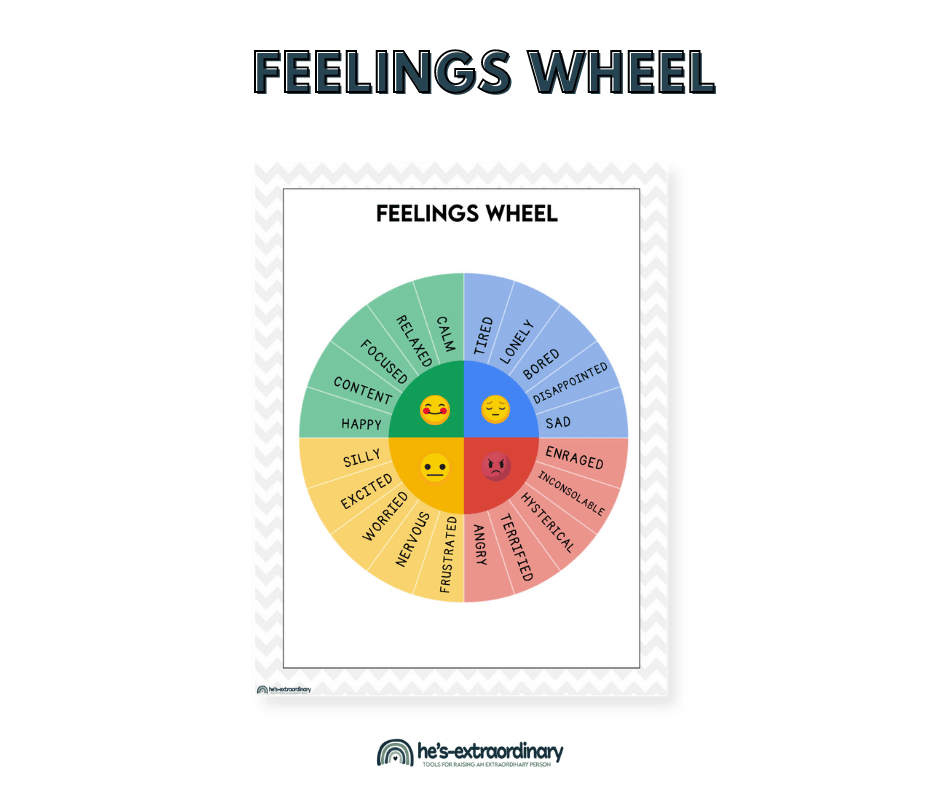Emotion Wheel for Kids: Free Printable + How to Use It
What’s inside this article: A modified version of Plutchik’s Emotion Wheel that’s suitable for use with children. Includes step-by-step instructions, age-specific guidance, activities for using the feelings wheel, troubleshooting tips, and a free printable download at the bottom of this article.
Does your child have meltdowns but can’t tell you why? Or maybe they say “I’m fine” when they’re clearly not?
Many kids struggle to identify and express their emotions, which can lead to frustration for both parents and children. When kids can’t put words to their feelings, they often use behavior to communicate instead – and that doesn’t always go well.
An emotion wheel is a simple visual tool that makes it easier for kids to recognize and communicate their feelings. Instead of guessing what’s wrong, you’ll finally have a way to help your child put words to those big feelings.
What is an Emotion Wheel?
An emotion wheel is a circular diagram that organizes different feelings to help kids identify what they’re experiencing. It’s basically a visual tool that makes naming feelings way easier for kids.
The original emotion wheel (pictured below) vwas created by psychologist Robert Plutchik in 1980. His wheel featured eight primary emotions in the middle ring:
- joy
- sadness
- anger
- fear
- trust
- disgust
- surprise
- anticipation

Plutchik’s wheel shows how emotions can vary in intensity – moving outward from the primary emotions shows lower intensity versions (like annoyance instead of anger), while moving inward shows higher intensity versions (like rage instead of anger).
The spaces between the emotion sections show combination emotions, like optimism (anticipation + joy) or love (joy + trust).
Plutchik’s brilliant insight was showing how emotions relate to each other and how they can vary in intensity. However, it’s a bit complex for a child (which is why I adapted it).
As a parent, you need something that actually works with real kids in real situations.
The version that I’ve created simplifies Plutchik’s wheel and color-codes emotions based on the Zones of Regulation, making it much more accessible for children.
I created the wheel this way so parents and teachers can use it to help kids identify their emotions. But, it can also be used to help them understand their energy levels and choose appropriate coping strategies if you want to use it as part of teaching the Zones.
This emotion wheel also works as a starting point with children to help expand their emotive vocabulary and build emotional intelligence. And trust me, once kids start using emotion words instead of just melting down, everything gets easier.
Why Teaching Emotions Actually Matters
Here’s something that might surprise you – being able to recognize emotions is a learnable skill, and it doesn’t come naturally to all kids.
When you ask a kid what they’re feeling, but they don’t know how to identify their feelings, it’s like asking someone to describe a color they’ve never seen before.
I’ve worked with countless families where parents assume their child is just being “difficult” when really, the child genuinely can’t identify what they’re feeling..
Kids who are able to identify what they’re feeling:
- Display fewer challenging behaviors (because they can use words instead of actions)
- Do better in school (emotional regulation supports learning)
- Are more empathetic and supportive of others
- Develop healthy coping skills and resilience
- Have a positive self-image
- Have positive and stable relationships with others

Although recognizing emotions comes naturally to a lot of children, it’s a really big struggle for some kids. When that’s the case, they often benefit from explicit teaching on how to identify their emotions.
This is especially true for neurodivergent children, who may experience emotions differently or have difficulty with interoception (awareness of internal body signals).
If your child is autistic, has ADHD, or sensory processing differences, an emotion wheel can be particularly helpful.
How The Emotion Wheel Works
Our emotion wheel is inspired by Plutchik’s research, but I’ve made some changes to make it more useful for families.
The biggest difference? I’ve color-coded the emotions based on the Zones of Regulation. This isn’t just about making it pretty; this helps give kids (and parents) a way to understand not just what they’re feeling, but what to do about it.
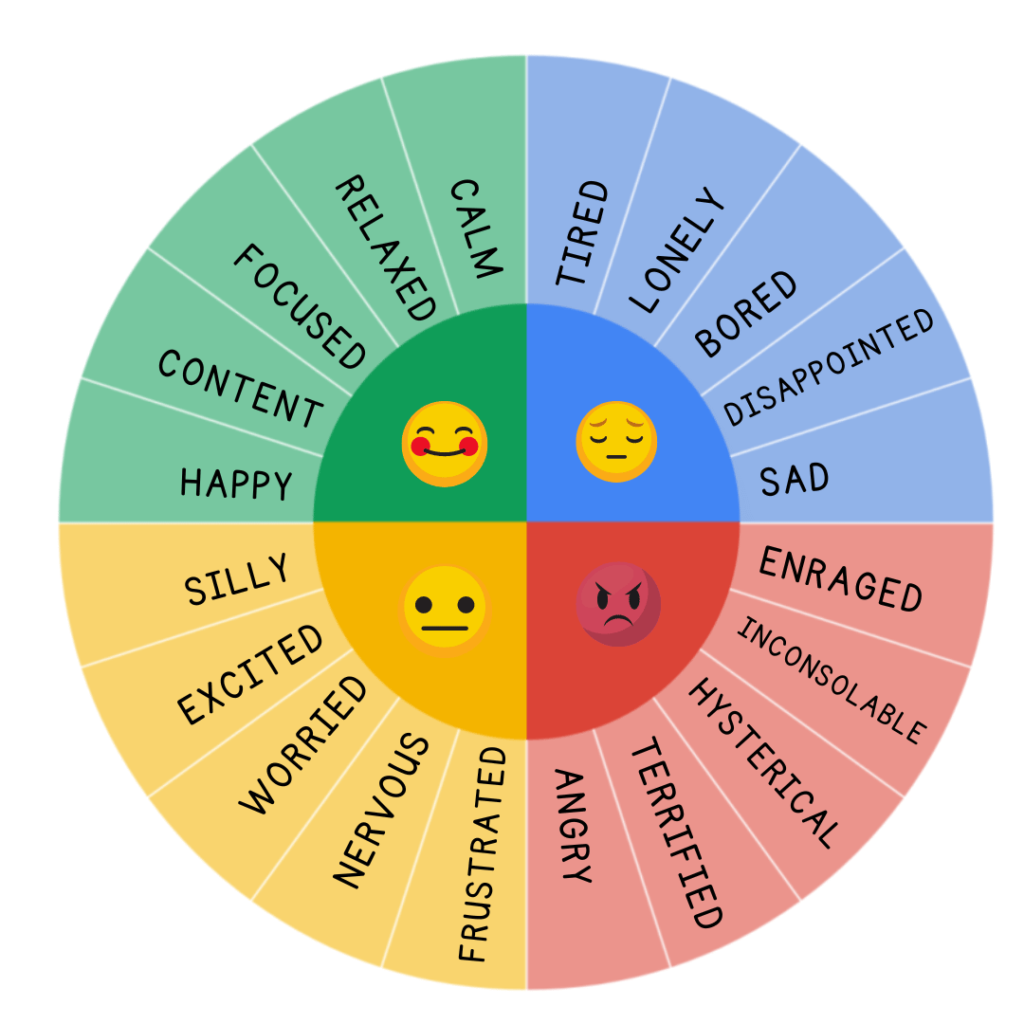
Here’s how the color coding works:
- Blue Zone: Low energy emotions (sad, tired, bored)
- Green Zone: Calm, regulated emotions (happy, peaceful, proud)
- Yellow Zone: Slightly elevated emotions (excited, worried, frustrated)
- Red Zone: High energy emotions (angry, terrified, overjoyed)
This connection helps kids understand not just what they’re feeling, but also their arousal level and what strategies might help them get back to the green zone. If the Zones of Regulation is new to you, you can read an overview of this social-emotional learning curriculum here.
Using the Emotion Wheel by Age
One size definitely doesn’t fit all when it comes to social-emotional learning.
Here are some ways to adapt your approach based on age (or developmental stage – always meet your child where they are):
- Ages 3-5:
Keep it simple. Focus on the basic emotions – happy, sad, mad, scared. Use simple language and point to facial expressions. Help them connect emotions to situations they understand: “You’re sad because your tower fell down.” - Ages 6-8:
You can start to introduce more emotion words and connect them to specific situations once kids understand the basics. Try phrases like “frustrated when things don’t work” or “disappointed when plans change.” Start discussing what each emotion feels like in their body – “When you’re angry, do your hands feel tight?” - Ages 9+:
As kids get older and understand how to name their emotions, you can start to explore intensity levels and help them understand that multiple emotions can happen at once. “I can see you’re excited about the party, but also nervous about not knowing anyone there.” Encourage them to use the wheel independently and discuss emotional regulation strategies together.
Understanding the Components of Emotions
Here’s something most people don’t realize – every emotion has three parts working together.
Understanding this helps both you and your child make sense of what’s happening.
1. Physiological
What happens in your body? What is your arousal level?
Arousal level refers to how alert and energized your body feels at any given moment. Think of it like your internal energy level – sometimes it’s high (like when you’re excited or stressed), sometimes it’s low (like when you’re tired or sad), and sometimes it’s in the middle. You’re well-regulated when your energy level matches what the situation calls for – high energy for playing, low energy for bedtime, and calm energy for learning.
In the Zones of Regulation, each zone actually represents a level of arousal. The emotions that fall into each zone have a similar effect on arousal.
The blue zone is low energy, green is calm and focused, yellow is slightly elevated, and red is extremely high energy.
But here’s where it gets interesting – there are more specific physiological responses associated with each emotion. For example, excitement and worry both fall into the yellow zone. Both emotions cause an elevated arousal level. However, the two emotions feel very different in your body.
2. Behavioral
This is how the emotion shows up in actions.
As I mentioned, you experience a similar arousal level when you’re both worried and excited. However, with worry, you may get fidgety and hypervigilant, but with excitement, you may be giggly and talk a lot.
Same energy level, completely different behaviors.
3. Cognitive
This refers to your thoughts and mental processes during an emotional experience.
This includes your thought patterns, how you label the emotion, the speed of your thoughts, and what you’re focusing on. A worried child might have racing thoughts about all the things that could go wrong, while an excited child’s thoughts are racing, thinking about all the fun possibilities.
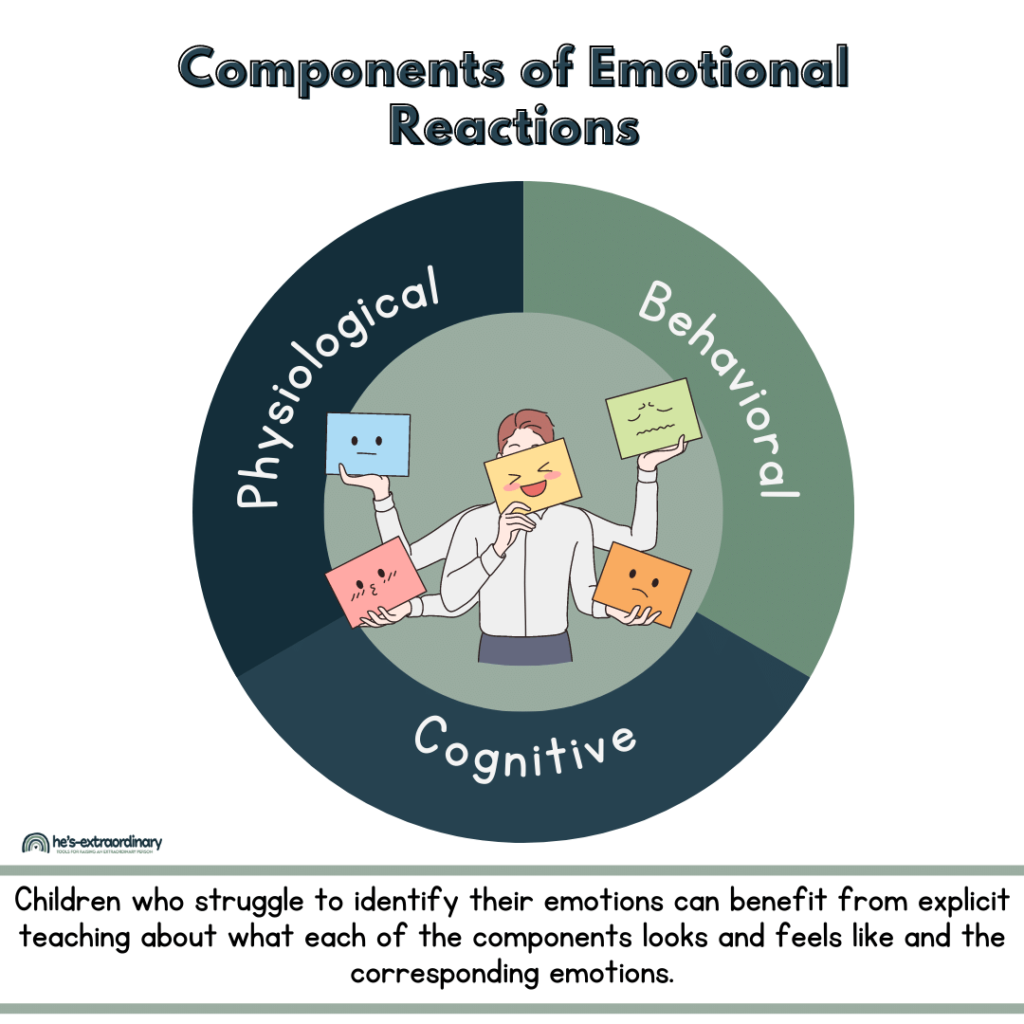
What is Emotional Regulation?
Emotional regulation is your ability to manage your emotional responses in a way that’s appropriate for the situation and helps you meet your goals. It’s not about suppressing emotions or always staying calm – it’s about having the skills to navigate your emotional experiences effectively.
Your nervous system is constantly taking in information and responding to it. Sometimes those responses are helpful (like feeling excited about a fun event), and sometimes they’re not (like staying anxious long after a stressful situation has passed).
Emotional regulation involves recognizing what’s happening in your nervous system and having strategies to support it.
This might look like calming down when you’re overwhelmed, but it could also mean energizing yourself when you’re feeling sluggish, or maintaining focus when you’re distracted.
Sometimes, regulation means allowing yourself to fully feel an emotion, and other times it means shifting your emotional state to match what the situation requires.
Strategies like taking deep breaths when frustrated, going for a walk to process big feelings, or using movement to increase alertness are all examples of emotional regulation tools.
The emotion wheel helps build these skills by giving children the language to identify what they’re experiencing. When kids can name their emotions and understand their arousal levels, they can start to choose strategies that actually work for them.
How to Use the Emotion Wheel with Your Child
The key to success is starting slow while your child is calm and building the habit gradually.
- Step 1: Introduce the wheel during a calm moment:
Don’t wait until your child is upset to introduce them to the emotion wheel. When kids are dysregulated, their thinking brain goes offline, and they can’t learn new information. Show them the wheel when they’re regulated and explain how it works. Make it interesting, say something like “Look at all these different feelings! I bet you’ve felt most of these.” - Step 2: Start with check-ins:
Use the wheel for regular emotion check-ins throughout the day. “How are you feeling right now? Can you point to it on the wheel?” Keep it light and brief – we’re building a habit, not conducting therapy. If your child isn’t interested in naming their feelings, you can name yours and move on. - Step 3: Connect emotions to zones:
If you’re doing the Zones of Regulation, help your child identify not just the emotion, but which zone it falls into. “I see you’re feeling frustrated – that’s a yellow zone emotion. What are some yellow zone strategies we could try?” - Step 4: Discuss strategies:
Once they identify their feelings, talk about what strategies might help. “What are some things we can do when we’re in the yellow zone?” Let them come up with ideas too. - Step 5: Practice during conflicts:
When emotions are elevated, gently guide them to the wheel. “Let’s take a look at the emotion wheel together. What are you feeling right now?” Stay calm yourself. Start slow and don’t expect or push for participation. You can try using emotion coaching to validate and help your child make connections over time.
25 Ways to Use The Emotion Wheel
There are so many creative ways to use the emotion wheel as a teaching tool.
The key is making it feel natural, not forced:
Daily Activities
- Morning emotion check-ins before school
- Bedtime reflection on the day’s emotions
- Check in after school
- Emotion tracking throughout the week
Learning Activities
- Pair the emotion wheel with Zones of Regulation activities and printables
- Use it as a starting point and brainstorm other emotions with your child. How many emotions can they think of?
- Go over this list of emotions here, and then decide which section on the emotion wheel some of them would fit into
- Have your child write or draw a picture about a time that they felt a particular emotion on the emotion wheel
Creative Activities
- Create emotion stories using the wheel and various prompts
- Draw or act out different emotions from the wheel, like a game of charades/pictionary
- Make emotion art – draw what anger looks like or sculpt how excited feels
- Have emotion dance parties where you move like different feelings
- Play guessing games with facial expressions and body language
- Create comics or picture books where the characters experience various emotions from the wheel
Social-Emotional Learning
- Play “emotion detective” with characters in books, TV shows, or movies – guess what they’re feeling and why
- Create family emotion check-ins where everyone shares their feelings from the day
- Look at family photos and guess what emotions everyone was experiencing when the picture was taken
- Play “emotion mirror,” where you copy each other’s facial expressions and guess the feeling
Practical Use
- Laminate and hang this up in your calming corner
- Use during conflict resolution between siblings
- Include in therapy or counseling sessions
- Incorporate into classroom emotional learning
Zones of Regulation Integration
- Complete the “What Zone are they in?” activity. Then, for each zone, examine the pictures and guess which emotion from the feelings wheel they are experiencing
- Connect zone strategies to specific emotions
- After successfully identifying what zone they are in, have your child choose which emotion from the emotion wheel they’re feeling.
Download the Emotion Wheel Printable
You can get the high-quality PDF version of this feelings wheel printable and use it at home or in the classroom.
Troubleshooting Common Challenges
Every family runs into bumps when starting to use emotional tools.
Here are the most common challenges and possible solutions:
“My child won’t use the emotion wheel.”
Start small – just point to emotions yourself when you notice them. “I see you smiling – you look happy!” Eventually, they may start engaging with it naturally. Don’t force participation or make it feel like a chore, just model it instead, keeping things light and non-demanding.
“My child says they don’t know how they feel.”
This is totally normal! A lot of kids truly don’t know what they are feeling. Help them by observing their body language and suggesting possibilities. “I notice your fists are clenched – are you feeling frustrated or angry?” Give them options rather than making them guess. Over time, your child will start to develop more emotional awareness.
“My child only says they feel ‘fine’ or ‘good'”
Gently redirect: “Fine tells me you’re okay, but what emotion are you feeling? Happy? Calm? Content?” Help them get more specific.
“My child picks extreme emotions for small problems.“
Sometimes what feels small to you really does feel huge to your child. For example, if your three-year-old says they feel devastated after their toy breaks, keep in mind that a broken toy could genuinely be the saddest thing that’s ever happened to a three-year-old, given their limited life experiences.
Start by providing comfort and co-regulation – if a child is feeling devastated or furious, they’ll need support calming their nervous system before they can explore their emotions or answer questions about what they’re feeling.
Once they’re more regulated, you can ask questions like: “Tell me more about feeling devastated. What does that feel like in your body?” or “That sounds really hard. Can you help me understand what made it feel so big?”
This validates their experience while helping them explore their emotions more deeply.
Frequently Asked Questions
At what age should I start using an emotion wheel?
You can start as early as age 3 with very simple emotions. The key is adapting your approach to your child’s developmental level. Don’t worry about perfection – focus on building awareness.
How is this different from other emotion wheels?
Our wheel uniquely combines Plutchik’s emotion theory with the Zones of Regulation framework, helping kids understand both their emotions and their arousal levels. It’s more practical for everyday parenting.
Can this help with autism or ADHD?
Absolutely! Many neurodivergent children benefit from visual tools for emotional identification. The zones connection is especially helpful for understanding sensory and arousal needs.
What if my child has difficulty with emotions?
Some children need extra support with emotional recognition and regulation. If you notice persistent challenges, consider consulting with an occupational therapist or counselor who specializes in emotional regulation.
How often should we use the emotion wheel?
Start with brief, regular check-ins rather than intensive sessions. Even 30 seconds a day can make a difference over time. Consistency matters more than duration.
Do I need to know about Zones of Regulation to use this?
Not at all! The color coding is helpful, but you can use this emotion wheel independently. If you want to learn more about the Zones, check out our other resources.
More Social-Emotional Learning Resources
There are lots of social-emotional learning resources available on the blog.
Here are some you may like:
- Understanding & Coping with Emotions Printable Mega Bundle
- 5 Minute Bio-Feedback Activity for Self-Regulation
- How Do I Feel? Emotions Activity Booklet
- Feelings Check-In & Emotion Chart
- Children’s Books about Emotions
- Therapy Games that Teach Emotional Regulation
- The Best Julia Cook Books for Social-Emotional Learning
- Kids Anger Management
